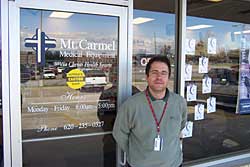Dealers on the Front Lines: David Hamilton, RRT, and Gary Miller, Director, Mt. Carmel Medical Equipment, Pittsburg, Kan.
 What led you to start covering the bariatric market?
What led you to start covering the bariatric market? Initial referrals came to us from our existing physician referral base. We made the decision to do our best to meet these patients’ needs so that our local physicians would continue to view us as the provider of choice. Other providers in our market elected to not offer service to this specific market.
How has bariatrics impacted your respiratory business?For our respiratory offerings, we need to ensure that we keep high-liter flow concentrators (10 liter) available and keep bi-PAP machines available for this specific segment of our business. Some providers may only have 5-liter concentrators and CPAP machines, and they may need to consider the additional equipment costs if they are going to provide service to this segment of the market.
What segment of your respiratory business is most influenced by bariatric patients and why?Home oxygen and home PAP therapy. As we continue to offer respiratory services to all patients, we have seen a small growth in our overall census that is directly related to the bariatric market. Bariatric patients need supplemental oxygen at a younger age, so companies may need to ensure that their specific state reimburses at a rate that makes providing this service acceptable.
Describe your relationship with bariatric referral sources in your area.We do not have a specific bariatric referral source. Since we are a Midwest rural provider, primary care physicians provide the majority of care in this area. There is not a specific bariatric treatment facility in our market area. The primary care physicians are aware of the services that we offer, so they are usually pleased that we can extend our usual services to this unique client base.
What advice would you give other providers looking to implement bariatrics into their respiratory business?Providers will want to evaluate their vendors to ensure that high-liter flow equipment is available; this may include liquid oxygen. They also will want to ensure that ready access to all types of PAP devices is quick and easy. Staff would need to be trained on the special needs of this segment of the population. Providers also will need to evaluate if they want to offer other types of bariatric equipment such as beds, walkers and wheelchairs.
This article originally appeared in the Respiratory Management May/June 2007 issue of HME Business.